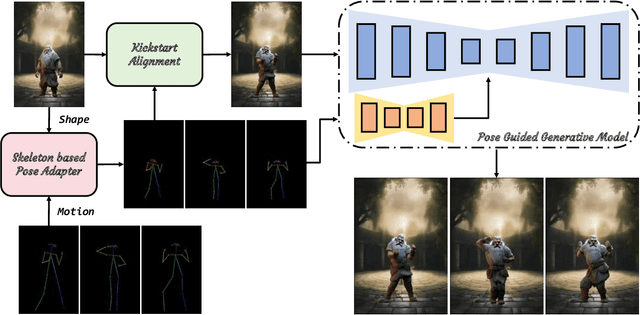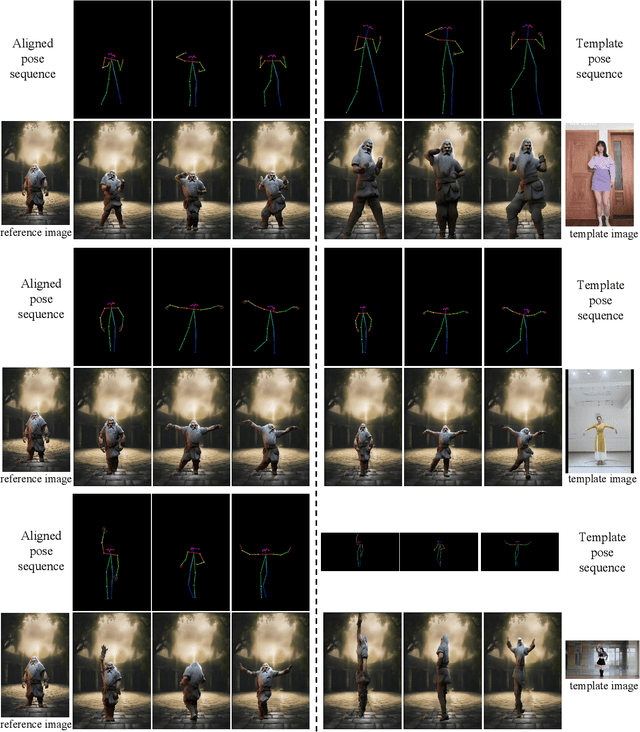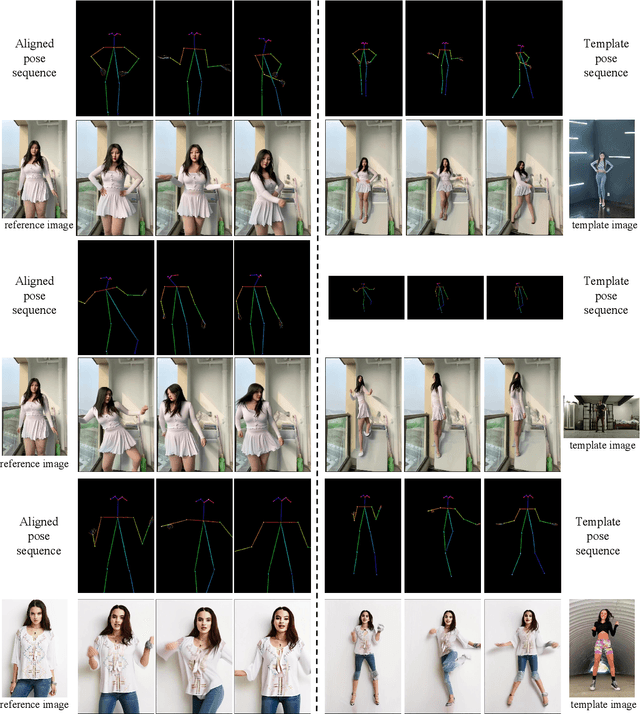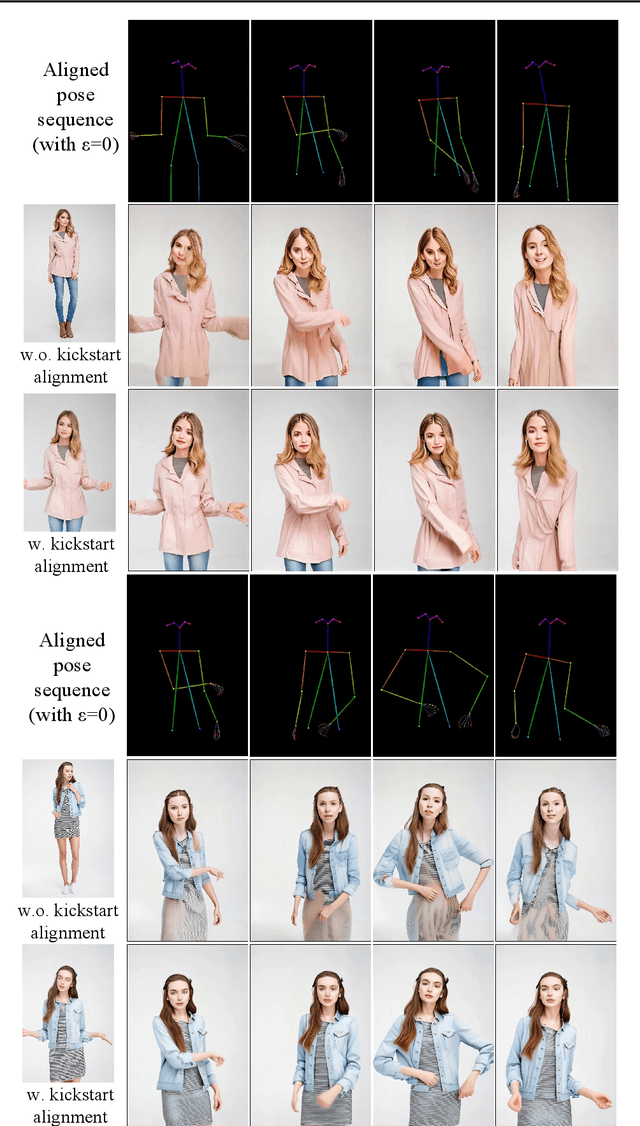Zunnan Xu
Refer to the report for detailed contributions
SAM-R1: Leveraging SAM for Reward Feedback in Multimodal Segmentation via Reinforcement Learning
May 28, 2025Abstract:Leveraging multimodal large models for image segmentation has become a prominent research direction. However, existing approaches typically rely heavily on manually annotated datasets that include explicit reasoning processes, which are costly and time-consuming to produce. Recent advances suggest that reinforcement learning (RL) can endow large models with reasoning capabilities without requiring such reasoning-annotated data. In this paper, we propose SAM-R1, a novel framework that enables multimodal large models to perform fine-grained reasoning in image understanding tasks. Our approach is the first to incorporate fine-grained segmentation settings during the training of multimodal reasoning models. By integrating task-specific, fine-grained rewards with a tailored optimization objective, we further enhance the model's reasoning and segmentation alignment. We also leverage the Segment Anything Model (SAM) as a strong and flexible reward provider to guide the learning process. With only 3k training samples, SAM-R1 achieves strong performance across multiple benchmarks, demonstrating the effectiveness of reinforcement learning in equipping multimodal models with segmentation-oriented reasoning capabilities.
InterAnimate: Taming Region-aware Diffusion Model for Realistic Human Interaction Animation
Apr 15, 2025Abstract:Recent video generation research has focused heavily on isolated actions, leaving interactive motions-such as hand-face interactions-largely unexamined. These interactions are essential for emerging biometric authentication systems, which rely on interactive motion-based anti-spoofing approaches. From a security perspective, there is a growing need for large-scale, high-quality interactive videos to train and strengthen authentication models. In this work, we introduce a novel paradigm for animating realistic hand-face interactions. Our approach simultaneously learns spatio-temporal contact dynamics and biomechanically plausible deformation effects, enabling natural interactions where hand movements induce anatomically accurate facial deformations while maintaining collision-free contact. To facilitate this research, we present InterHF, a large-scale hand-face interaction dataset featuring 18 interaction patterns and 90,000 annotated videos. Additionally, we propose InterAnimate, a region-aware diffusion model designed specifically for interaction animation. InterAnimate leverages learnable spatial and temporal latents to effectively capture dynamic interaction priors and integrates a region-aware interaction mechanism that injects these priors into the denoising process. To the best of our knowledge, this work represents the first large-scale effort to systematically study human hand-face interactions. Qualitative and quantitative results show InterAnimate produces highly realistic animations, setting a new benchmark. Code and data will be made public to advance research.
Separate to Collaborate: Dual-Stream Diffusion Model for Coordinated Piano Hand Motion Synthesis
Apr 14, 2025Abstract:Automating the synthesis of coordinated bimanual piano performances poses significant challenges, particularly in capturing the intricate choreography between the hands while preserving their distinct kinematic signatures. In this paper, we propose a dual-stream neural framework designed to generate synchronized hand gestures for piano playing from audio input, addressing the critical challenge of modeling both hand independence and coordination. Our framework introduces two key innovations: (i) a decoupled diffusion-based generation framework that independently models each hand's motion via dual-noise initialization, sampling distinct latent noise for each while leveraging a shared positional condition, and (ii) a Hand-Coordinated Asymmetric Attention (HCAA) mechanism suppresses symmetric (common-mode) noise to highlight asymmetric hand-specific features, while adaptively enhancing inter-hand coordination during denoising. The system operates hierarchically: it first predicts 3D hand positions from audio features and then generates joint angles through position-aware diffusion models, where parallel denoising streams interact via HCAA. Comprehensive evaluations demonstrate that our framework outperforms existing state-of-the-art methods across multiple metrics.
Audio-visual Controlled Video Diffusion with Masked Selective State Spaces Modeling for Natural Talking Head Generation
Apr 03, 2025Abstract:Talking head synthesis is vital for virtual avatars and human-computer interaction. However, most existing methods are typically limited to accepting control from a single primary modality, restricting their practical utility. To this end, we introduce \textbf{ACTalker}, an end-to-end video diffusion framework that supports both multi-signals control and single-signal control for talking head video generation. For multiple control, we design a parallel mamba structure with multiple branches, each utilizing a separate driving signal to control specific facial regions. A gate mechanism is applied across all branches, providing flexible control over video generation. To ensure natural coordination of the controlled video both temporally and spatially, we employ the mamba structure, which enables driving signals to manipulate feature tokens across both dimensions in each branch. Additionally, we introduce a mask-drop strategy that allows each driving signal to independently control its corresponding facial region within the mamba structure, preventing control conflicts. Experimental results demonstrate that our method produces natural-looking facial videos driven by diverse signals and that the mamba layer seamlessly integrates multiple driving modalities without conflict.
FireEdit: Fine-grained Instruction-based Image Editing via Region-aware Vision Language Model
Mar 25, 2025Abstract:Currently, instruction-based image editing methods have made significant progress by leveraging the powerful cross-modal understanding capabilities of vision language models (VLMs). However, they still face challenges in three key areas: 1) complex scenarios; 2) semantic consistency; and 3) fine-grained editing. To address these issues, we propose FireEdit, an innovative Fine-grained Instruction-based image editing framework that exploits a REgion-aware VLM. FireEdit is designed to accurately comprehend user instructions and ensure effective control over the editing process. Specifically, we enhance the fine-grained visual perception capabilities of the VLM by introducing additional region tokens. Relying solely on the output of the LLM to guide the diffusion model may lead to suboptimal editing results. Therefore, we propose a Time-Aware Target Injection module and a Hybrid Visual Cross Attention module. The former dynamically adjusts the guidance strength at various denoising stages by integrating timestep embeddings with the text embeddings. The latter enhances visual details for image editing, thereby preserving semantic consistency between the edited result and the source image. By combining the VLM enhanced with fine-grained region tokens and the time-dependent diffusion model, FireEdit demonstrates significant advantages in comprehending editing instructions and maintaining high semantic consistency. Extensive experiments indicate that our approach surpasses the state-of-the-art instruction-based image editing methods. Our project is available at https://zjgans.github.io/fireedit.github.io.
HunyuanPortrait: Implicit Condition Control for Enhanced Portrait Animation
Mar 25, 2025Abstract:We introduce HunyuanPortrait, a diffusion-based condition control method that employs implicit representations for highly controllable and lifelike portrait animation. Given a single portrait image as an appearance reference and video clips as driving templates, HunyuanPortrait can animate the character in the reference image by the facial expression and head pose of the driving videos. In our framework, we utilize pre-trained encoders to achieve the decoupling of portrait motion information and identity in videos. To do so, implicit representation is adopted to encode motion information and is employed as control signals in the animation phase. By leveraging the power of stable video diffusion as the main building block, we carefully design adapter layers to inject control signals into the denoising unet through attention mechanisms. These bring spatial richness of details and temporal consistency. HunyuanPortrait also exhibits strong generalization performance, which can effectively disentangle appearance and motion under different image styles. Our framework outperforms existing methods, demonstrating superior temporal consistency and controllability. Our project is available at https://kkakkkka.github.io/HunyuanPortrait.
Densely Connected Parameter-Efficient Tuning for Referring Image Segmentation
Jan 15, 2025Abstract:In the domain of computer vision, Parameter-Efficient Tuning (PET) is increasingly replacing the traditional paradigm of pre-training followed by full fine-tuning. PET is particularly favored for its effectiveness in large foundation models, as it streamlines transfer learning costs and optimizes hardware utilization. However, the current PET methods are mainly designed for single-modal optimization. While some pioneering studies have undertaken preliminary explorations, they still remain at the level of aligned encoders (e.g., CLIP) and lack exploration of misaligned encoders. These methods show sub-optimal performance with misaligned encoders, as they fail to effectively align the multimodal features during fine-tuning. In this paper, we introduce DETRIS, a parameter-efficient tuning framework designed to enhance low-rank visual feature propagation by establishing dense interconnections between each layer and all preceding layers, which enables effective cross-modal feature interaction and adaptation to misaligned encoders. We also suggest using text adapters to improve textual features. Our simple yet efficient approach greatly surpasses state-of-the-art methods with 0.9% to 1.8% backbone parameter updates, evaluated on challenging benchmarks. Our project is available at \url{https://github.com/jiaqihuang01/DETRIS}.
HunyuanVideo: A Systematic Framework For Large Video Generative Models
Dec 03, 2024



Abstract:Recent advancements in video generation have significantly impacted daily life for both individuals and industries. However, the leading video generation models remain closed-source, resulting in a notable performance gap between industry capabilities and those available to the public. In this report, we introduce HunyuanVideo, an innovative open-source video foundation model that demonstrates performance in video generation comparable to, or even surpassing, that of leading closed-source models. HunyuanVideo encompasses a comprehensive framework that integrates several key elements, including data curation, advanced architectural design, progressive model scaling and training, and an efficient infrastructure tailored for large-scale model training and inference. As a result, we successfully trained a video generative model with over 13 billion parameters, making it the largest among all open-source models. We conducted extensive experiments and implemented a series of targeted designs to ensure high visual quality, motion dynamics, text-video alignment, and advanced filming techniques. According to evaluations by professionals, HunyuanVideo outperforms previous state-of-the-art models, including Runway Gen-3, Luma 1.6, and three top-performing Chinese video generative models. By releasing the code for the foundation model and its applications, we aim to bridge the gap between closed-source and open-source communities. This initiative will empower individuals within the community to experiment with their ideas, fostering a more dynamic and vibrant video generation ecosystem. The code is publicly available at https://github.com/Tencent/HunyuanVideo.
AToM: Aligning Text-to-Motion Model at Event-Level with GPT-4Vision Reward
Nov 27, 2024



Abstract:Recently, text-to-motion models have opened new possibilities for creating realistic human motion with greater efficiency and flexibility. However, aligning motion generation with event-level textual descriptions presents unique challenges due to the complex relationship between textual prompts and desired motion outcomes. To address this, we introduce AToM, a framework that enhances the alignment between generated motion and text prompts by leveraging reward from GPT-4Vision. AToM comprises three main stages: Firstly, we construct a dataset MotionPrefer that pairs three types of event-level textual prompts with generated motions, which cover the integrity, temporal relationship and frequency of motion. Secondly, we design a paradigm that utilizes GPT-4Vision for detailed motion annotation, including visual data formatting, task-specific instructions and scoring rules for each sub-task. Finally, we fine-tune an existing text-to-motion model using reinforcement learning guided by this paradigm. Experimental results demonstrate that AToM significantly improves the event-level alignment quality of text-to-motion generation.
Alignment is All You Need: A Training-free Augmentation Strategy for Pose-guided Video Generation
Aug 29, 2024



Abstract:Character animation is a transformative field in computer graphics and vision, enabling dynamic and realistic video animations from static images. Despite advancements, maintaining appearance consistency in animations remains a challenge. Our approach addresses this by introducing a training-free framework that ensures the generated video sequence preserves the reference image's subtleties, such as physique and proportions, through a dual alignment strategy. We decouple skeletal and motion priors from pose information, enabling precise control over animation generation. Our method also improves pixel-level alignment for conditional control from the reference character, enhancing the temporal consistency and visual cohesion of animations. Our method significantly enhances the quality of video generation without the need for large datasets or expensive computational resources.
 Add to Chrome
Add to Chrome Add to Firefox
Add to Firefox Add to Edge
Add to Edge